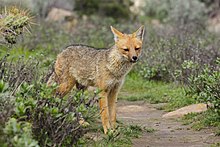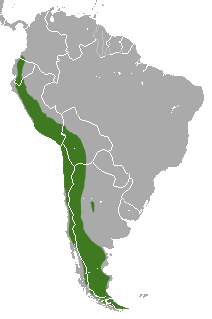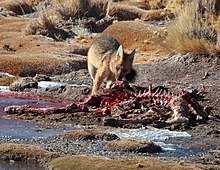Culpeo
| Culpeo | |
|---|---|

| |
| Culpeo in Peru | |
| Scientific classification | |
| Domain: | Eukaryota |
| Kingdom: | Animalia |
| Phylum: | Chordata |
| Class: | Mammalia |
| Order: | Carnivora |
| Family: | Canidae |
| Genus: | Lycalopex |
| Species: | L. culpaeus
|
| Binomial name | |
| Lycalopex culpaeus (Molina, 1782)
| |

| |
| Culpeo range | |
The culpeo (Lycalopex culpaeus), also known as culpeo zorro, Andean zorro, Andean fox, Paramo wolf,[3] Andean wolf,[4] and colpeo fox,[4] is a species of South American fox. Despite the name, it is not a true fox, but more closely related to wolves and jackals. Its appearance resembles that of foxes due to convergent evolution.
The culpeo's diet consists largely of rodents, rabbits, birds and lizards, and to a lesser extent, plant material and carrion. They may prey on Andean flamingos and baby vicuña. The culpeo occasionally attacks sheep and is, therefore, often hunted or poisoned.[5] In some regions, it has become rare, but overall the species is not threatened with extinction.
The culpeo was domesticated by the Selk'nam people of Tierra del Fuego, producing the Fuegian dog which became extinct in the late 19th or early 20th century.[6]
Description

The culpeo is a canid intermediate in size between a red fox and a coyote. It is the second-largest native canid on the continent after the maned wolf. In appearance, it bears many similarities to the widely recognized red fox. It has grey and reddish fur, a white chin, reddish legs and a stripe on its back that may be barely visible. The average weight of the male is 11.4 kg (25 lb), while the typically smaller females average 8.4 kg (19 lb). Overall, a weight range of 5 to 13.5 kg (11 to 30 lb) has been reported. Total length can range from 94 to 133 cm (37 to 52 in), including a tail of 32 to 44 cm (13 to 17 in) in length.[7] The pelt has a grizzled appearance. The neck and shoulders are often tawny to rufous in color, while the upper back is dark. The bushy tail has a black tip.[8]
Range

The culpeo's range extends from the southern regions of Patagonia and Tierra del Fuego in the south to Ecuador and Peru in the north, with some populations extending into southern Colombia. It is also found in the Sierras Grandes mountain range in Córdoba, Argentina.[9] It is most common on the western slopes of the Andes, where it inhabits open country and deciduous forests.
Habitat
The culpeo lives in a wide variety of habitats of western South America. They are found in
Diet

The culpeo is an opportunistic predator that will take any variety of prey. It mainly feeds on rodents (including
Reproduction
The typical mating period is between August and October. After a gestation period of 55–60 days, the female gives birth usually to between two and five pups.
Classification
Subspecies
-
Lycalopex culpaeus andinus (Thomas, 1914)
-
Lycalopex culpaeus culpaeus (Molina, 1782)
-
Lycalopex culpaeus lycoides (Philippi, 1896)
-
Lycalopex culpaeus magellanicus (Gray, 1837)
-
Lycalopex culpaeus reissii (Hilzheimer, 1906)
Taxonomy
The taxonomy of the culpeo has been the topic of debate due to their high
This canid, like other South American foxes, is still sometimes classified as a member of the genus Pseudalopex.[1] As Pseudalopex and Lycalopex have largely come to describe the same genus, either classification is acceptable, although the modern practice is to give Lycalopex prominence.[17]
References
- ^ . Retrieved 12 November 2021.
- ^ "Appendices | CITES". cites.org. Retrieved 2022-01-14.
- .
- ^ a b Comparative ecology of two South American foxes, 'Dusicvon ariseus' and 'culpaeus' by Warren E. Johnson. Doctoral dissertation. Iowa State University; 1992. p2. Accessed July 10, 2021 at https://lib.dr.iastate.edu/cgi/viewcontent.cgi?article=11006&context=rtd
- ISBN 978-0-19-851555-5.
- doi:10.1016/j.quaint.2013.07.030. Archived from the original(PDF) on December 20, 2016. Retrieved September 2, 2020.
- ISBN 0789477645. p. 182
- ^ JSTOR 3504483. Archived from the original(PDF) on 2013-05-14 – via www.science.smith.edu.
- ^ "Zorro Colorado" (PDF). Ministerio de Ambiente y Desarollo Sustentable de Argentina (in Spanish). Retrieved 6 Jan 2023.
- S2CID 84525738.
- ^ a b "Lycalopex culpaeus (Culpeo)". Animal Diversity Web.
- ^ Alderton, David. Foxes, Wolves, and Wild Dogs of the World. London: Blandford, 1998. p175-6.
- ISSN 0165-0521.
- S2CID 11176126.
- ^ molina 1782
- ^ Jiménez, J.E.; Novaro, A.J. (2004). "Chapter 3.4: Culpeo (Pseudalopex culpaeus)". In Sillero-Zubiri, C.; Hoffmann, M.; Macdonald, D.W. (eds.). Canids: Foxes, Wolves, Jackals, and Dogs. Archived from the original (PDF) on 2011-10-06. Retrieved 2012-05-08.
- OCLC 62265494.
- S2CID 4338513.)
{{cite journal}}: CS1 maint: numeric names: authors list (link - ISBN 978-1845931872.






